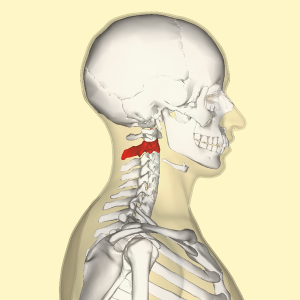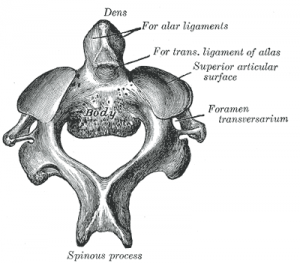Axis: Difference between revisions
No edit summary |
No edit summary |
||
| Line 6: | Line 6: | ||
== Introduction == | == Introduction == | ||
[[Image:C2 lateral.png|thumb|right]][[Image:Axis.png|thumb|right]] The Axis (C2 vertebra) also known as epistropheus forms the pivot upon which the first cervical vertebra (the [[Atlas]]), which carries the head, rotates.<ref>Axis (anatomy) - Wikiwand /www.wikiwand.com/en/Axis_(anatomy) (accessed 26 June 2018)</ref> | [[Image:C2 lateral.png|thumb|right]][[Image:Axis.png|thumb|right]] The Axis (C2 vertebra) also known as epistropheus forms the pivot upon which the first cervical vertebra (the [[Atlas]]), which carries the head, rotates.<ref>Axis (anatomy) - Wikiwand /www.wikiwand.com/en/Axis_(anatomy) (accessed 26 June 2018)</ref> The axis is composed of a vertebral body, heavy pedicles, laminae, and transverse processes, which serve as attachment points for muscles. The axis articulates with the atlas via its superior articular facets, which are convex and face upward and outward. | ||
== Structure == | == Structure == | ||
| Line 12: | Line 12: | ||
=== Odontoid process === | === Odontoid process === | ||
The most distinctive characteristic of this bone is the strong [[Odontoid Process]] (also known as the "dens") which rises perpendicularly from the upper surface of the body. Posteriorly the Odontoid process is flattened where it articulates with the transverse ligament. | The most distinctive characteristic of this bone is the strong [[Odontoid Process]] (also known as the "dens") which rises perpendicularly from the upper surface of the body.It is a prominent rounded superior projection from the body.This tooth-like elevation serves a stable point around which the atlas bone rotates. Posteriorly the Odontoid process is flattened where it articulates with the transverse ligament.<ref>Cervical Spine Anatomy: Overview, Gross Anatomy https://emedicine.medscape.com/article/1948797-overview#a2 (accessed 26 June 2018)</ref> | ||
=== Vertebral body === | === Vertebral body === | ||
| Line 26: | Line 26: | ||
The '''transverse processes''' are very small, and each ends in a single tubercle; each is perforated by the transverse foramen, which is directed obliquely upward and laterally. | The '''transverse processes''' are very small, and each ends in a single tubercle; each is perforated by the transverse foramen, which is directed obliquely upward and laterally. | ||
The '''superior articular | The '''superior articular facets''' are round, slightly convex, directed upward and laterally,It articulates with the inferior articular facet on the altas bone above (C1) to form the atlantoaxial joint. | ||
The '''inferior articular | The '''inferior articular facets''' lies posterior to the transverse process and is directed downwards and forwards to articulate with the third cervical vertebra. | ||
The '''superior vertebral notches''' are very shallow, and lie behind the articular processes; the inferior lie in front of the articular processes, as in the other cervical vertebrae. | The '''superior vertebral notches''' are very shallow, and lie behind the articular processes; the inferior lie in front of the articular processes, as in the other cervical vertebrae. | ||
The '''spinous process''' is large, very strong, deeply channelled on its under surface, and bifid. | The '''spinous process''' is large, very strong, deeply channelled on its under surface, and bifid.<ref>B D Chaurasia's Human Anatomy Regional and Applied Dissection and Clinical Volume 3 Head, Neck and Brain Fourth edition CBS Publishers and distributors</ref> | ||
== References == | == References == | ||
Revision as of 08:37, 26 June 2018
Original Editor - Rachael Lowe
Top Contributors - Mandeepa Kumawat, Admin, Kim Jackson, George Prudden and WikiSysop
Introduction[edit | edit source]
The Axis (C2 vertebra) also known as epistropheus forms the pivot upon which the first cervical vertebra (the Atlas), which carries the head, rotates.[1] The axis is composed of a vertebral body, heavy pedicles, laminae, and transverse processes, which serve as attachment points for muscles. The axis articulates with the atlas via its superior articular facets, which are convex and face upward and outward.
Structure[edit | edit source]
Odontoid process[edit | edit source]
The most distinctive characteristic of this bone is the strong Odontoid Process (also known as the "dens") which rises perpendicularly from the upper surface of the body.It is a prominent rounded superior projection from the body.This tooth-like elevation serves a stable point around which the atlas bone rotates. Posteriorly the Odontoid process is flattened where it articulates with the transverse ligament.[2]
Vertebral body[edit | edit source]
The body is deeper in front than behind, and prolonged downward anteriorly so as to overlap the upper and front part of the third vertebra. It presents in front a median longitudinal ridge, separating two lateral depressions for the attachment of the Longus colli muscles. Its under surface is concave from before backward and convex from side to side.
Other Structures[edit | edit source]
The pedicles are broad and strong, especially in front, where they coalesce with the sides of the body and the root of the odontoid process. They are covered above by the superior articular surfaces.
The laminae are thick and strong, and the vertebral foramen large, but smaller than that of the atlas.
The transverse processes are very small, and each ends in a single tubercle; each is perforated by the transverse foramen, which is directed obliquely upward and laterally.
The superior articular facets are round, slightly convex, directed upward and laterally,It articulates with the inferior articular facet on the altas bone above (C1) to form the atlantoaxial joint.
The inferior articular facets lies posterior to the transverse process and is directed downwards and forwards to articulate with the third cervical vertebra.
The superior vertebral notches are very shallow, and lie behind the articular processes; the inferior lie in front of the articular processes, as in the other cervical vertebrae.
The spinous process is large, very strong, deeply channelled on its under surface, and bifid.[3]
References[edit | edit source]
References will automatically be added here, see adding references tutorial.
- ↑ Axis (anatomy) - Wikiwand /www.wikiwand.com/en/Axis_(anatomy) (accessed 26 June 2018)
- ↑ Cervical Spine Anatomy: Overview, Gross Anatomy https://emedicine.medscape.com/article/1948797-overview#a2 (accessed 26 June 2018)
- ↑ B D Chaurasia's Human Anatomy Regional and Applied Dissection and Clinical Volume 3 Head, Neck and Brain Fourth edition CBS Publishers and distributors








